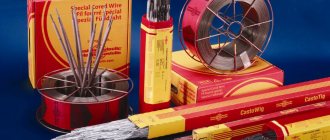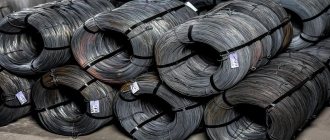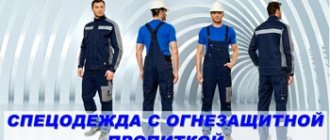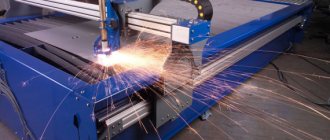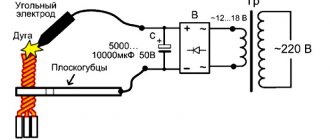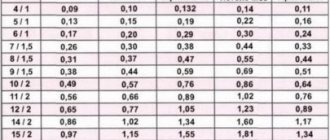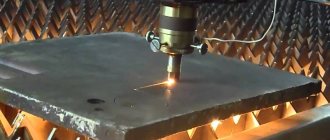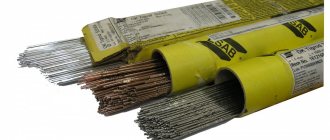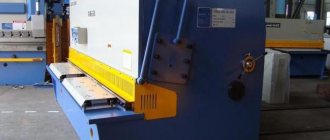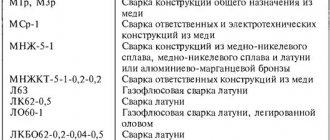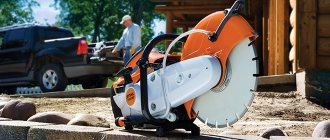Connecting metal structures by welding is the most common method in construction, instrument making, and production of machines and mechanisms.
In the welding process, two surfaces are joined after the base metal is melted by heat. An additional welding element is used, which forms a weld or surfacing after cooling and crystallization. The welding material is introduced into the workspace using a consumable, current-carrying, non-consumable electrode or gas welding. In the process of work, welding materials perform work: when melting, moving in an arc, being in a bath, solidifying, they protect the molten metal; alloy and deoxidize the metal, adjusting the chemical composition of steels; remove oxides, slag, phosphorus and sulfur from the weld filling; free the suture mass from nitrogen and hydrogen.
Classification of materials for welding
The large number of materials required for joining metals by welding makes it difficult to accurately classify, but the main welding materials are divided as follows: filler wire for welding and surfacing; for arc welding, piece electrodes; wire and plate electrodes for slag welding; filler additive materials of non-continuous, solid, tubular cross-section; filler drawn, rolled, drawn cast rods and wire, surfacing strips with powder coating; flammable gas or oxygen; welding equipment, compressor; gas cylinders; a generator for producing acetylene from calcium carbide or an acetylene cylinder under pressure; reducer to reduce welding gas pressure; torches for welding, hardening, surfacing with a set of necessary types of tips of different diameters; rubber hoses for moving oxygen; fluxes and powders for welding.
SELECTION OF WELDING CONSUMABLES
When welding high-strength low-alloy steels of the pearlitic class, welding materials are usually used that provide the pearlitic structure of the weld metal.
The chemical composition of welding materials (electrode rods, electrode or filler wire) for this purpose is selected from the same alloying system as the base metal, limiting the content of carbon, sulfur and phosphorus in it. The uniform strength of the connection is guaranteed by creating an appropriate seam section. When calculating the chemical composition of a weld (and therefore its mechanical properties), it is necessary to take into account the additional alloying of the weld metal due to the share of the base metal in it; this proportion varies widely for different welding methods. The identical structural composition of the weld metal and the base metal with approximately the same strength makes it possible to use automatic welding with modes that provide a sufficiently large cross-section of the passage. This allows the number of passes to be reduced compared to manual welding.
The reinforcement of the seam (Fig. 8.4, a) is small (and equal strength is ensured). As mentioned above, the tendency of pearlitic metal to form cold cracks depends (in addition to the structural factor) on the hydrogen content in the weld metal. Its content must be limited, which requires the use of low-hydrogen electrodes with type B coating. Before use, the electrodes must be calcined at a temperature of 350...500 °C.
| a - for welding with pearlite materials; b - when welding with austenitic materials; c - for slot cutting |
Using perlite welding materials, you can use not only manual welding with coated electrodes, but also mechanized welding under a layer of flux or in a shielding gas environment. In this case, to reduce the hydrogen content, calcination of the flux is required at a temperature of 600...700 °C, and the moisture content in the shielding gas (carbon dioxide, argon or mixtures) is limited to very strict standards.
High technological strength and workability of the weld metal when welding high-strength pearlitic steels can be
obtain when it contains combinations within certain limits of the following elements: C, Si, Mn, Cr, Ni, V, Mo, Nb. With a certain quantitative content of these elements in the weld metal, its strength sv can fluctuate within 600...700 MPa in the initial state after welding and 850...1450 MPa after appropriate heat treatment.
Another option is possible - the use of austenitic welding materials. Austenite has lower strength, and in order to obtain equal strength welded joints it is necessary to significantly increase the cross-sections of the welds. Thus, in some cases, the magnitude of the reinforcement of butt welds can reach 0.3S (Fig. 8.4, b). This leads to two consequences:
• firstly, the complexity of making a connection sharply increases, especially considering that the cross-section of the passage during multilayer welding is limited due to the fear of diluting the austenitic weld metal with too large a share of the base pearlitic metal;
• secondly, due to the relatively sharp descent of high reinforcement to the base metal, a geometric stress concentration is formed in this area (see Fig. 8.4, b), which can lead to the early appearance of a crack during the operation of the structure. Therefore, it is necessary to apply special, so-called “fillet” beads to reduce the geometric stress concentration in this place, or to use mechanical processing (milling) to provide a fillet at the transition point with a radius of at least 12 mm.
The positive aspects of using austenitic materials is their lower sensitivity to hydrogen. Hydrogen dissolves well in austenite, and its diffusion mobility in the crystal lattice is limited - this significantly reduces the flow of hydrogen from the weld into the HAZ, so there are no strict requirements for its normalization in the weld. In addition, an austenitic weld, compared to a pearlitic one, has significantly greater ductility, which is very useful under operational overloads. Specific brands of electrodes and flux-wire systems are selected depending on the composition of the base metal (steel grade), guided by regulatory documentation.
As can be seen from the above, one of the main difficulties in welding the steels under consideration is the danger of obtaining martensitic structures. If it is not possible to avoid them due to technological methods, then it is necessary to apply heat treatment to the structure after welding. It is advisable to carry out this operation immediately after welding, until the temperature in the weld area drops below the martensitic transformation temperature characteristic of a given steel grade.
A common (after welding) heat treatment is tempering with heating at 600...700 °C and holding for about two hours. Such tempering helps to transfer the structure to a more equilibrium state (martensite to sorbitol), relieve residual welding stresses and partially remove diffusion-mobile hydrogen from the welded joint. Welded structures for critical purposes (high-pressure steam pipelines, nuclear reactor vessels, steam-producing equipment, boilers, etc.) are necessarily subjected to this heat treatment. Heat treatment can be general (sometimes in specially made furnaces) or local (induction heating in the area of the seams). Welded joints made with austenitic materials, as a rule, are not subjected to post-welding heat treatment.
Melting wires, plates and rods
This type of electrode is used for gas-shielded, submerged arc, and electroslag welding. Steel wire, as a welding material, is divided into high-alloy, low-carbon and alloy. In total, 77 types of similar products are determined by assortment. By selecting the required brands, the chemical composition of the seam is changed. Typically, a wire composition similar to the metal being welded is used. The characteristics of the welding material must comply with GOST and are indicated on the packaging.
Alloy and low-carbon steels for the manufacture of wire are divided into copper-plated and non-copper-plated. For manual welding, wire is used, chopped into pieces ranging from 360 to 400 mm in length. Supplied to the consumer in skeins weighing from 20 to 85 kg. All coils are equipped with labels indicating the manufacturer and technical parameters of the wire.
The plates are used for electroslag welding. Manual arc welding is performed using a specially coated metal electrode rod called an electrode. Electrodes are divided depending on the thickness and composition of the applied layer and the quality of workmanship. Depending on the thickness, there are particularly thick, medium and thin coatings.
Three groups in GOST serve to divide electrodes depending on the accuracy of manufacture and the content of sulfur and phosphorus in the coating composition. The type of welding material coated with stabilizing, binding, deoxidizing, and alloying components is indicated by the letters:
- coating with acid additives – A;
- the main classic option is B;
- coating with the addition of cellulose - C;
- mixed materials in the surface layer – P.
Classification
The following types are distinguished:
Wire
The welding wire and consumable rod electrodes made on its basis are heated in the electric arc flame, gradually reach the melting point and flow into the weld pool . There they are mixed with metal from the melted edges of the workpiece. After moving the electrode and arc further along the connection line, the melt crystallizes, connecting both workpieces into a single whole.
The welding wire is fed into the working area semi-automatically at a constant speed. It contains the necessary alloying additives. Based on this feature, wire is divided into the following types:
- low carbon;
- alloyed;
- highly alloyed.
The choice of wire is determined by the material of the workpieces. Its chemical composition should be close to the composition of the alloys being welded. Alloying additives are used to improve the quality of the weld. Copper plating of wire is also used.
In addition, wire and fusible electrodes are used as elements of the welding electrical circuit . Voltage is applied through them, and when the tip of the wire touches the workpiece, an electric arc is ignited. In the case of semi-automatic welding with a non-consumable electrode in an atmosphere of protective gases, current flows through it. The mechanical feeder only feeds filler wire or tape. The standards provide for 77 different grades of welding wire.
Tape and rods
In manual welding with a non-fusible electrode, the filler rod is fed into the work area by the welder .
To do this, the wire is cut into pieces 200-300 mm long and supplied in bundles. For welding, select a rod that is closest in chemical composition to the workpiece material. Welding tape is used in surfacing when it is necessary to supply filler material in a wide thin layer. The tape is made from the same alloys as welding wire.
Electrodes
Rod electrodes today are the most widely used in manual welding with an inverter MMA machine . They are straight pieces of welding wire from 200 to 450 mm long, coated with a special layer of coating. This electrode serves as a conductor, supplying voltage to the arc. From its heat, the wire core melts and flows into the weld pool, replenishing the suture material.
The coating burns at high temperatures, releasing protective gases. Gases prevent contact between molten metal and air. The coating also includes additives to increase the stability of the arc and facilitate its ignition. Some additives (such as rutile) make it possible to weld high-quality seams in difficult conditions, even when the workpiece is wet and covered with traces of corrosion.
Gases
Welding gases are used as a heat source in gas welding and cutting. For this, oxygen is used as an oxidizer and the following gases as fuel:
- acetylene;
- hydrogen;
- industrial propane;
- methyl acetylene mixture.
Which fuel is the most efficient?
Hydrogen has the highest specific combustion energy, and it is also the most explosive. Used for a limited range of welding operations. High purity acetylene is used for welding critical joints. For ordinary welding, propane is used; it is the cheapest gas. Oxygen is mixed with combustible gas in the burner to increase the flame temperature. In addition to welding gases, which serve as a heat source, arc welding also uses so-called shielding gases . They are fed into the work area, displace air from there and block the access of oxygen, nitrogen and water vapor to the weld pool.
For welding critical joints made of stainless alloys, inert gases argon or helium, as well as their mixtures, are used. They are also used for aluminum, titanium and other light metals. For routine welding of structural steels, carbon dioxide is used to protect the working area.
Fluxes
Fluxes are used in liquid or powder form.
Liquid fluxes are used to chemically prepare the weld area. With their help, the oxide film on the surface of the workpiece is removed, simultaneously degreasing. Strong inorganic compounds - alkalis or acids - act as liquid fluxes. The chemical composition should be selected depending on the alloy being processed. After processing, the workpiece must be washed with water and dried thoroughly.
Flux powders are used as a source of shielding gas. The powder burns in the arc flame and releases protective gas.
When manual welding, it is poured along the seam line. Flux material for automatic welding is supplied to the welding zone from a hopper through a hose.
In addition to the release of protective gases, such a flux can also serve as a heat conductor, accelerating the heating of the edges. This is how various grades of steel and cast iron are cooked.
In addition to the listed varieties, ceramic backing plates are also used. With their help, the melt is prevented from flowing out and a reverse seam bead is formed.
Non-consumable welding rods and electrodes for machine welding
To connect surfaces in shielding gases, special welding materials are used. The definition of such welding is given as a process that uses an electric arc between an electrode and a surface as a heat source. Round tungsten electrodes with a diameter of 5-10 mm supply electric current to the arc area. Pure tungsten is used as a material or additives of lanthanum, yttrium, and sodium dioxide oxides are added. Tungsten itself cannot be replaced with a cheaper metal, since it is the most refractory, with a high boiling point (5900 ºC) and is used for welding with direct and alternating current.
Certification of welders. From December 1, 2021, new GOST standards for welding come into force.
Certification of welders. From December 1, 2021, new GOST standards for welding come into force.
GOST R ISO 9606-1-2020 Certification tests of welders. Fusion welding. Part 1. Steel
Approved by: Federal Agency for Technical Regulation and Metrology, 07/08/2020.
Entered from: 01.12.2020. The standard establishes requirements for the qualification of welders for fusion welding of steels. The standard establishes technical rules for conducting periodic certification tests of welders, regardless of the type of product, its location and certification by an expert or expert body. When qualifying a welder, the focus is on the welder's ability to manually manipulate an electrode holder, welding torch or gas torch and produce a weld joint of the required quality. The standard applies to manual or partially mechanized fusion welding processes. The standard does not apply to fully mechanized and automatic welding processes. GOST ISO 15609-5-2020 Technical requirements and certification of welding procedures for metallic materials.
Technical requirements for the welding procedure. Part 5. Resistance welding Approved by: Federal Agency for Technical Regulation and Metrology, 07/08/2020.
Entered from: 01.12.2020. The standard specifies resistance welding procedure specifications for spot, seam, flash butt and projection welding processes. Before any qualification is carried out, it is necessary to establish the applicability of the provisions of the standard to other resistance welding processes and related welding processes. The parameters listed in the standard affect weld dimensions (quality), weld position, mechanical properties or weld geometry. GOST ISO 15609-3-2020 Technical requirements and certification of welding procedures for metallic materials.
Technical requirements for the welding procedure. Part 3. Electron beam welding Approved by: Federal Agency for Technical Regulation and Metrology, 07/08/2020.
Entered from: 01.12.2020. The standard specifies technical requirements for the electron beam welding procedure. The standard is part of a series of standards, details of which are given in EN ISO 15607:2003, Annex A. The parameters given in the standard affect the quality and properties of the welded joint. GOST ISO 6848-2020 Arc welding and cutting.
Non-consumable tungsten electrodes. Classification Approved by: Federal Agency for Technical Regulation and Metrology, 07/08/2020.
Entered from: 01.12.2020. The standard specifies the classification of non-consumable tungsten electrodes for inert gas arc welding and for plasma welding, cutting and thermal spraying. GOST ISO 14171-2020 Welding materials.
Solid wires, flux cored wires and wire/flux combinations for submerged arc welding of unalloyed and fine grain steels. Classification Approved by: Federal Agency for Technical Regulation and Metrology, 07/08/2020.
Entered from: 01.12.2020. The standard specifies requirements for the classification of wire/flux combinations based on the as-welded and heat-treated characteristics of the weld metal in submerged arc welding of unalloyed and fine-grained steels with a minimum yield strength of not more than 500 MPa or with a minimum tensile strength of not more than 570 MPa. One flux can be classified with various solid wires and cored wires. Solid wires are also classified separately based on chemical composition. The standard combines technical requirements that provide classification using a system based on values of yield strength and average impact energy for weld metal of 47 J, and using a system based on values of tensile strength and average impact energy of 27 J: a) clauses, subclauses and tables that include a final "A" in their numbering refer only to wire/flux combinations where the wire is classified using a system based on the yield strength and average impact energy values for 47 J weld metal in accordance with this standard; b) Clauses, subclauses and tables that include a final "B" in their numbering apply only to wire/flux combinations where the wire is classified using a system based on tensile strength values and an average impact energy of 27 J in accordance with this standard; c) Clauses, subclauses and tables that are not numbered with a final letter “A” or “B” apply to all wire/flux combinations where the wire is classified in accordance with this standard. Fluxes for single-pass and double-pass welding are classified based on the two-pass welding technology. GOST ISO 14341-2020 Welding materials.
Wires and weld metal of gas-shielded consumable electrode arc welding of unalloyed and fine-grained steels. Classification Approved by: Federal Agency for Technical Regulation and Metrology, 07/08/2020.
Entered from: 01.12.2020. The standard establishes requirements for the classification of electrode wires and deposited metal after welding and heat treatment. The classification is used for gas shielded consumable electrode arc welding of unalloyed and fine-grained steels with a minimum yield strength of not more than 500 MPa or a minimum tensile strength of not more than 570 MPa. One wire can be tested and classified in different shielding gases. The standard specifies general technical requirements to provide classification based on a system based on yield strength and 47 J average impact energy for the weld metal, or on a system based on tensile strength and 27 J average impact energy for the weld metal: a) clauses, subclauses and tables with the letter index "A" are used only for electrode wires classified according to the system based on the yield strength and average impact energy of 47 J for the weld metal in accordance with this standard; b) Clauses, subclauses and tables with the letter "B" apply only to electrode wires classified according to the system based on tensile strength and an average impact energy of 27 J for the weld metal in accordance with this standard; c) Clauses, subclauses and tables without the suffix letter “A” or “B” apply to any electrode wire classified in accordance with this standard. GOST ISO 9692-2-2020 Welding and related processes.
Types of connection preparation. Part 2. Submerged arc welding of steels Approved by: Federal Agency for Technical Regulation and Metrology, 07/08/2020.
Entered from: 01.12.2020. The standard specifies types of joint preparation for submerged arc welding of steels (process 121 in accordance with ISO 4063). The standard only applies to welding positions PA and PB in accordance with ISO 6947. For welding positions PC, special joint preparation is required. The standard applies to full penetration welds. For partial penetration welds, joint preparation types and dimensions may differ from those defined in this standard if they are defined in the relevant standards or agreed upon by the parties concerned. If the root of the weld is made by another arc welding process (see ISO 4063), then joint preparation in accordance with ISO 9692-1 should be considered. GOST ISO 9692-3-2020 Welding and related processes.
Types of connection preparation. Part 3. Inert gas arc welding with consumable and tungsten electrodes of aluminum and its alloys Approved by: Federal Agency for Technical Regulation and Metrology, 07/08/2020.
Entered from: 01.12.2020. The standard specifies the types of joint preparation for MIG (131) TIG welding (131), TIG (141) TIG welding with solid filler material (wire or rod), and TIG (141) TIG welding. without filler material TIG (142) aluminum and its alloys. The standard applies to full penetration welds. GOST ISO/TR 15608-2020 Welding.
Guidelines for the grouping system of metallic materials Approved by: Federal Agency for Technical Regulation and Metrology, 07/09/2020.
Entered from: 01.12.2020. The standard establishes a unified system for grouping metallic materials as applied to welding. This system can be used for other purposes such as heat treatment, stamping, non-destructive testing. The standard applies to systems for grouping standardized materials: - steel; — aluminum and its alloys; — nickel and its alloys; — copper and its alloys; — titanium and its alloys; — zirconium and its alloys; - cast iron. GOST R ISO 3580-2020 Welding materials.
Coated electrodes for manual arc welding of heat-resistant steels. Classification Approved by: Rosstandart, 06/18/2020.
Entered from: 01.12.2020. The standard specifies requirements for the classification of coated electrodes for manual arc welding of ferritic, martensitic creep-resistant steels and low-alloy steels operating at elevated temperatures, the classification being based on the properties of the weld metal after heat treatment. The standard establishes general technical requirements to provide classification based on a system based on chemical composition, yield strength and average impact energy, or a system based on tensile strength and chemical composition of the weld metal: a) clauses, subclauses and tables with the letter suffix “A” apply only for electrodes classified by a system based on chemical composition, yield strength and average impact energy for the weld metal in accordance with the standard; b) clauses, subclauses and tables with the letter “B” apply only to electrodes classified according to the system based on tensile strength and chemical composition of the deposited metal; c) clauses, subclauses and tables without the letter suffix “A” or “B” apply to any electrodes classified in accordance with the standard. GOST R ISO 9692-4-2020 Welding and related processes.
Recommendations for preparing connections. Part 4. Clad steels Approved by: Federal Agency for Technical Regulation and Metrology, 06/18/2020.
Entered from: 01.12.2020. The standard specifies types of joint preparation for clad steels. GOST R IEC 60974-4-2020 Equipment for arc welding.
Part 4. Periodic inspection and testing Approved by: Federal Agency for Technical Regulation and Metrology, 06/18/2020.
Entered from: 01.12.2020. The standard establishes procedures for testing equipment during periodic inspections and after repairs to ensure electrical safety. These test procedures are also applicable for maintenance. The standard applies to power supplies for arc welding and related processes conforming to IEC 60974-1 or IEC 60974-6. Tests of self-contained ancillary equipment conforming to other parts of IEC 60974 may also be carried out in accordance with the standard. NKPROM
NKPROM.RU is an expert in the field of industrial safety, training and education of personnel according to non-destructive testing standards. Call
127410
Russia
Moscow region
Moscow
Altufevskoe highway, 43 building 2
8
Application of oxygen
Oxygen is heavier than air, it promotes the combustion of gases and vapors at high speed, which releases heat and reaches a high melting point. The interaction of compressed oxygen with fatty oils and lubricants leads to spontaneous ignition and explosion, so work with oxygen cylinders is carried out in clean conditions, without the danger of such contamination. Storage of oxygen-type welding materials is carried out in compliance with fire safety standards.
Oxygen for welding is technical, obtained from the atmosphere. The air is processed in special separation devices, carbon dioxide impurities are removed, and the final product is dried. Liquid oxygen for transportation and storage requires special containers with increased thermal insulation.
Main types:
- welding electrodes with various coatings (acidic, mixed, cellulose, rutile) and filler rods;
- wire - activated. powder, solid;
- fluxes;
- gases - protective, flammable;
- ceramic pads for connecting different types of seams - all-position, round, etc.
Products are divided into groups according to the type of metal being welded: for joining elements made of carbon steels, for stainless and low-alloy steels, as well as for copper, cast iron, etc.
Electrodes and wire
These two types of welding consumables provide power to the welding area. Coated consumable electrodes, certain types of wire, and protective flux contain components that help protect the metal from oxidation. They maintain stable operation and help obtain the desired chemical composition of the seam. The filler rod is introduced into the seam directly during welding.
Consumable wires are used under submerged arc, in shielding gases and in electroslag welding. Technological standards require the use of different types of steel wires: alloyed, high-alloyed and low-carbon. Alloy and low-carbon steel can be copper-plated or non-copper-plated.
When choosing a particular brand, you need to take into account that the chemical composition of the seam will depend on it. Typically, a material is used that is closest in composition to the metal being processed. It must comply with GOST requirements - the composition is indicated on the product packaging.
When choosing a welding material for welding, pay attention to the workmanship. The surface of the product must be smooth, without traces of grease, scale and rust. The melting index should not be lower than that of the materials being joined.
Rods and plates
Electroslag welding is performed using plates, while arc welding is performed using metal rods coated with an electrode. Electrodes are thin, medium thickness and thick.
Products are marked with letters depending on the type of coating:
- A - with acid additives;
- B - traditional option;
- C - containing cellulose;
- P - mixed.
Gases
For gas welding, flammable gases and gases that support combustion are used, in particular:
- oxygen;
- hydrogen;
- acetylene;
- propane-butane mixture;
- methyl acetylene allene fraction.
Shielding gases are also used to protect the melt from air: carbon dioxide, helium, argon and various mixtures.
Remember safety: compressed oxygen when interacting with lubricants and oils can ignite or cause an explosion. Welding materials of this type must be stored in strict compliance with fire safety standards. Acetylene, when heated rapidly to high temperatures, can also lead to an explosion - it is important to strictly follow the operating technology.
Use of acetylene
Acetylene is a compound of oxygen and hydrogen. This flammable gas is in a gaseous state at normal temperatures. The colorless gas contains impurities of ammonia and hydrogen sulfide. The flammable component of the material is dangerous. Welding pressure of more than 1.5 kgf/cm2 or accelerated heating to 400 ºС is enough to cause an explosion. Gas is produced by an electric arc discharge, which promotes the separation of liquid flammable components or by the decomposition of calcium carbide under the influence of moisture.
Gas substitutes for acetylene
Requirements for welding materials allow the use of liquid vapors and other gases for work. They are used if the heating temperature exceeds twice the melting rate of the metal. For the combustion of different types of gases, one or another amount of oxygen entering the burner is required. Combustible substances are used instead of acetylene because of their low cost and the possibility of widespread production. They are used in various industries, but the use of substitutes is limited by their relatively low heating range.
Wire and welding fluxes
Unknown wire of an unidentified brand is not used for welding. The surface of the filler wire is smooth, free of rust, scale, and grease. It is selected according to the melting index, which is lower than this characteristic of the steels being welded. One of the quality properties of the wire is its gradual melting without sudden splashes. As an exception, if the required wire is not available, for welding brass, lead, copper, and stainless steel, strips of cut metal from the same material that is being joined are used. When welding metals such as aluminum, magnesium, copper, brass, cast iron, active interaction of non-ferrous castings with oxygen from the atmosphere or an oxidizing flame occurs. The reaction leads to the formation of oxides with a high melting point, which create a harmful film and make it difficult for the substance on the surface to transition to a liquid state. A welding material called flux, consisting of a paste or powder of the appropriate composition, is used to protect the surface of the molten mass. The material is boric acid, calcined borax. Fluxes are not used when welding alloy steels.
Welding and welded materials T.1
4.2.1. Changing the dimensions of the edge groove during welding
Movements of the edges of the welded parts in the direction across the seam occur due to local expansion of the metal near the welding source and transverse shrinkage of the already welded and cooling section of the seam. In the case of electroslag welding, when the transverse shrinkage is several millimeters and the seam is up to several meters in length, movements of the edges can lead to the termination of the welding process either due to an increase in the gap and leakage of the weld pool, or due to the complete closing of the gap and the impossibility of feeding the filler wire. In cases where the welding process does not completely stop, a significant change in the quality of welding is possible, since when the welding gap changes, the composition and properties of the seam change. When arc welding, it is also possible for lack of penetration and metal leaks to appear at the root of the weld. Longitudinal shrinkage often causes bending of the welded plates in the plane (crescent) and loss of stability. In this case, the mutual movements of the edges in the plane of the plates being welded and in the thickness direction are summed up with errors in the shape of the edges being welded and errors during assembly and can lead to the impossibility of welding and a decrease in the quality of the weld. Significant movements of the edges in the direction of the thickness of the plates are observed when welding thin-sheet structures of low rigidity.
4.2.2. Changing the shape and size of the structure
Distortions caused by welds impair the appearance and sometimes reduce the performance of the structure. In sheet structures, the causes of movement are angular deformations and loss of stability during longitudinal shrinkage. Beams from the application of longitudinal and transverse seams experience shortening, bending and twisting (Fig. 4.8). The magnitude of displacements can be estimated using the methods given in 4.3.1.4.
4.2.3. Residual stress
Residual tensile stresses create a reserve of energy in the metal, which can contribute to the destruction of the metal. They also help accelerate corrosion processes. The associated plastic deformations lead to a decrease in the ductility of the joint. When combined with operating stresses, residual stresses impair the performance of the structure: compressed elements may lose stability; in elements operating under variable loads, the endurance limit is reduced; in elements working in bending, the rigidity of the section decreases due to the transition of part of the section to a plastic state. Residual stresses significantly affect the accuracy and dimensional stability of welded parts. During machining, due to the redistribution of residual stresses, the shape and dimensions of the part change. Under the influence of residual stresses, creep deformations occur, especially at elevated temperatures. When a working load is first applied, the working stresses, adding to the residual ones, can in some places exceed the yield strength and high. call plastic deformation. The deformations occurring under the influence of residual stresses usually do not exceed fractions of a percent.
4.3. Determination of welding strains, stresses and displacements
4.3.1. Calculation methods
4.3.1.1. Main stages of calculation.
Calculation of welding deformations and stresses consists of determining:
1) temperature fields during welding;
2) free temperature deformations and deformations from structural transformations, mechanical properties of the material, depending on temperature;
3) own deformations, stresses and displacements. To carry out the calculation, the following inputs are required:
data:
1. Characteristics of the welding heat source, heat removal conditions and thermophysical properties of materials (heat capacity coefficients cf. thermal conductivity of heat transfer from the surface). Reference data and methods for calculating temperature fields are given in Chapter 2.
2. Dilatometric characteristics of the materials forming the welded joint. When welding dissimilar materials or using filler material...
Safety water seals
The device for protecting the rubber pipeline and the gas generator from the return of backfire from the burner is called a shutter. The requirements for welding materials determine that the water seal is designed in such a way that it prevents the oxygen or acetylene mass in the hole of the torch or cutter from igniting. A water seal is necessarily included in the equipment; this is a fire safety requirement that must be met. The valve is placed in the space between the cutter and the burner; according to the instructions, it is in good condition and is periodically filled with water to the required level. This device is the main one in the chain of welding equipment.
Cylinders for storing compressed gases
Cylinders are made in the form of cylindrical steel vessels. The conical hole in the neck area is closed with a shut-off valve on the thread. The cylinder walls are connected using a seamless method; the material is alloy and carbon steel. External coloring makes it possible to recognize the type of gas placed inside. Oxygen is transported in blue vessels, acetylene cylinders are painted white, the yellow-green tint indicates the hydrogen content, and other flammable gases are placed in red containers.
The passport data of the gas is written on the top of the cylinder. The requirement for storing welding materials requires that the cylinders be installed vertically and secured to the wall with a clamp. The valves of oxygen storage cylinders are made of brass; the use of steel is not permitted due to the corrosion of materials in a gas environment. The taps of acetylene gas cylinders are made of steel; it is prohibited to use copper and an alloy with a copper content of more than 70%. Acetylene reacts with copper to form an explosive mixture.
Gas reducers
A welding material such as a reducer serves to relieve gas pressure from the cylinder and maintain the indicator at a constant level during the entire operating time, regardless of the decrease in the pressure of the substance in the cylinder. Gearboxes are produced in two-chamber and single-chamber types. The former work more productively, maintain constant pressure and do not freeze during prolonged use of gas mixtures. To supply gas to the burner, rubber hoses with fabric gaskets are used, which undergo preliminary testing for strength and pressure resistance, about which there are special documents. Hoses for oxygen and acetylene are used separately. To supply kerosene and gasoline, hoses made of material resistant to gasoline are used.
Requirements for materials for welding
For any type of welding, materials are used in accordance with strict standards, where acceptance and inspection requirements are clearly defined. All batches used for the production of welding materials in the factory are supplied with a certificate indicating technical indicators: manufacturer's trademark; symbols consisting of letters and numbers indicating the brand and type; serial number of the batch of heat and shift; indicator of the surface condition of the electrode or wire; chemical composition of the alloy indicating the percentage; mechanical characteristics of the resulting weld weld; net weight.
The general requirements for all electrodes are a stable burning arc and a well-formed seam. The metal of the resulting surfacing corresponds to a predetermined chemical composition, the melting of the rod during operation occurs evenly, without splashing or releasing toxic substances. The wire contributes to the production of high-quality welding, slag from the surface of the seam is easily removed, and the coating of the seam is durable. The electrodes retain technical parameters for a long time. Every detail is important to complete the welding process. The use of high-quality materials in the work plays an important role in the process of stable and durable joining of metals.
REQUIREMENTS FOR PREPARATION AND STORAGE OF METAL WELDING MATERIALS
The wire should be transported and stored under conditions that prevent rusting, contamination and mechanical damage.
If the surface of the wire is dirty or covered with rust, it must be cleaned before use. The wire is cleaned when winding it onto cassettes in special machines using sanding wheels. Kerosene, white spirit, gasoline, etc. are used to remove oils. Some factories use heat treatment to remove moisture: calcination at a temperature of 100-150 °C.
The presence of traces of grease or other contaminants is not allowed. In most cases, cleaning from oxides is also required. To remove fatty contaminants, degreasing is used. The oxide film is removed by etching, chemical and electrochemical polishing.
The welding wire must be chemically cleaned in the following sequence:
- removal of preservative grease by washing with hot water or solvents (acetone, white spirit);
- etching the wire for 5-20 minutes in a solution of the following composition: caustic soda 8-12 g/l, soda ash 40-50 g/l, trisodium phosphate 40-50 g/l;
- washing in hot water at a temperature not lower than 50 C;
- rinsing in cold running water;
- clarification in a solution consisting of chromic anhydride (100 g/l) and sulfuric acid with a density of 1.84 g/cm 3 (10 mg/l) at a temperature of 15-25 C. Clarification is carried out until the dark coating disappears;
- rinsing in cold running water;
- washing in hot running water at a temperature not lower than 50°C;
- drying at a temperature of 60-80°C until moisture is completely removed.
The shelf life of wire ready for welding should not exceed one day.
There is no need to treat the electrode wire before welding if you use copper-plated wire.
Quality control of welding wire. GOST 2246-70 for steel welding wire and 10543-63 for steel surfacing wire establish: grade and diameters of welding wire, chemical composition, acceptance rules and test methods, requirements for packaging, labeling, transportation and storage.
Each coil of welding wire must have a metal tag indicating the name and trademark of the manufacturer, the symbol of the wire according to the standard and the batch number.
The certificate accompanying the batch of wire contains the following data: trademark of the manufacturer, symbol of the wire, heat and batch number, condition of the surface of the wire (copper-plated or non-copper-plated), chemical composition in percent, tensile test results, failure weight (net) in kilograms.
Thus, the presence of a tag attached to the coil of welding wire, as well as a certificate for the wire, is a guarantee that the wire is suitable for welding. The surface of the welding wire should be free of scale, rust, dirt and oil. High-alloy steel wire should not have any residual graphite lubricant.
Welding wire, for which there is no documentation, is subjected to careful control. The most important thing is to check the chemical composition of the wire, for which each batch is selected for analysis, the grade of welding wire is determined and the possibility of its use for welding is determined in accordance with the technological process.
Electrode quality control. When welding structures whose drawings indicate the type of electrode, electrodes that do not have a certificate cannot be used. Electrodes without a certificate are carefully monitored. At the same time, in accordance with GOST 9466-60, 9467-60, 10051-62, 10052-62*, the strength of the coating, the welding properties of the electrodes are checked, the mechanical properties of the weld metal and welded joint are determined on samples welded with electrodes from the tested batch. The suitability of electrodes for welding is also judged by the quality of the deposited metal, which should not have pores, cracks or slag inclusions.
The appearance of the electrodes must meet the requirements of the standard, which states that the electrode coating must be durable, dense, without pores, cracks, swelling and lumps of unmixed components. Electrodes with a damp coating are not allowed into production.
Electrodes that have passed the test are prepared for welding in a dry-heat oven, where they can be calcined at a temperature of 100-150°C in order to remove water from the coating.
